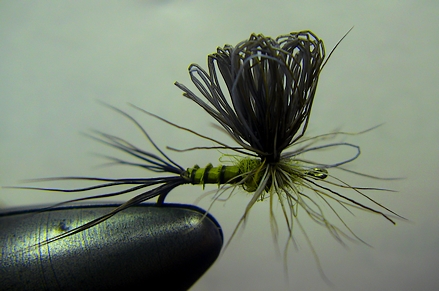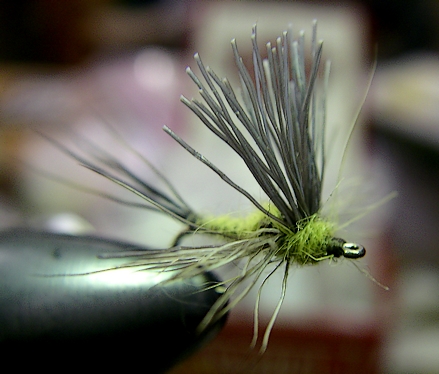It was a comment made by Alex at 40 Rivers to Fish that had me pondering fly tying as a whole. Like all artisans you wake one morning and realize you’ve explored most continents – and wonder is this the pinnacle of the craft, and after years of toil – are there no dragons left to slay?
Two or three hundred years of small hooks and smaller feathers doesn’t leave many Everest’s to climb, and with the few surviving manuscripts of “them as came before”, you never know whether it’s really invention or modification you’re working on.
Most real innovation in fly tying has come from new synthetic materials, rather than technique. Simple items we’ve taken for granted hold a great deal more promise than their older counterparts – and poring over countless synthetic fashion yarns has introduced new worlds for me to conquer.
The Granddaddy of all fly tying mountains has been hackle, and most tiers will admit that the big dollars is invested in their collection of genetic chickens, and the unending desire to accumulate more colors and rarer strains to assist in either floating flies or imitating the terrestrial bug.
So long as that continent remains untamed, there’s plenty of uncharted territory for the tinker tyer.
Despite all the synthetics we’ve grown from test tube, and despite the efforts of thousands of fly tiers attempting to find a substitute, only the Haystack/Comparadun series of Caucci-Natasi has yielded an adequate substitute for hackle. Some may argue that the Swisher-Richards No Hackle was viable – but mallard wings don’t stand up to abuse and once tattered, may be eaten as a caddis emerger versus the fully terrestrial mayfly dun.
Cul Du Canard (CDC) has its legion of followers, but most flies are hybrids – a mixture of CDC and chicken hackle – not the truly hackle-free dry that would free us forever of the genetic chicken.
In response to the larger question, I’d suggest there’s a great deal more real estate for the journeyman fly tyer – but it’s rarified turf, a combination of physical properties and technique, where you’ll have to know the first and invent the other.
I’ve attempted Everest many times, and this year I’ve got working prototypes. Chicken farmers are safe, it’ll take a couple more seasons to figure out the tool I need to tie these blazing fast, but the physical qualities are sound, the materials tough as nails, and all I really need are some hungry and desperate fish to make me feel the effort was warranted.
There’s still plenty of refinement needed in both form and execution, and my Brownline activities don’t offer the ability to test dry fly theory – most hatches are Trico or Caenis and I’m reluctant to fish things I can’t see – hackled or otherwise.
I’ve never seen their likeness anywhere – but that doesn’t mean some canny Victorian fly tyer didn’t get tired of his stringy old roosters and use Red Deer in a similar fashion – the only advantage I have is his work was lost to Time.
Flies float because of combination of surface tension and square footage. Meaning, materials heavier than water can float so long as they occupy enough surface to prevent the fly from sinking. Chicken hackle itself is not lighter than water, neither is the hook, tail, or dubbing.
The hackle above the water provides no flotation, neither does the hackle underwater, so it’s the cross section that occupies enough real estate to resist sinking.
Drop a needle into the water point first and it sinks instantly, lay it on the water lengthwise, carefully, and it’ll float.
The answer to our Everest is to find a substitute material that’ll provide the same cross section as chicken – and if it’s durable and cheap, we’ve got something.
Like the Caucci-Natasi Haystack/Comparadun, I’m exploiting deer hair.
The profile is a parachute dry, which after a couple decades of intensive personal use, I fish more frequently than the traditional Catskill dries popularized over the last century.

This is the lightly dressed variant, a Blue Wing Olive in size 16. Dun gray elk hair is tied in as the wing, then bent 180 degrees and flared around the post. Wing length and “hackle” retain traditional proportions. The whip finish is spun around the wing rather than the hook shank, as the wing is the final component of the fly.
I had an idea that I could cut the wing loops and pull down more hackle if the fly was fished in broken water. If it works you’ll be able to adjust the amount of hackle with your nippers.
That and you could sever the wing to make the spinner, leaving a little nub so you can pick it out from all the other naturals in the surface film.
The heavier hackled variant is tied completely differently and is still in the beta phase. I’m hoping to finish a couple dozen for the season Opener, which’ll give me and SMJ something to giggle over while fishing.

Above is #16 Pale Morning Dun using the “heavier hackle” construction method. I didn’t put too much more hackle on this version, but this style allows me to reduce the wing mass despite the use of more elk hair. Hackle and wing are a single bunch of elk/deer that’s trimmed to produce the final wing shape.
I guess I’d answer 40 River’s comment with something different; you spend a couple decades painfully mastering the craft, and when you look around and see nothing that stimulates you, it’s time to stimulate others, taking the craft one small step past your comfort zone.
For me, the tinkering component is an endless amount of hideous barriers to overcome; chicken hackle a physical obstacle, and angler perception an emotional barrier, both await some fellow not satisfied with a McGinty – and wonders can he make a better bug’s arse with a popsicle stick.

Given all the interesting new stuff you’ve been tying, we’re going to need a minimum two weeks on the river to try it all out properly.
…and just what makes you think I’m sharing?
I was thinking you might be willing to part with some of your flies in exchange for some of the teriyaki beef jerky I made up this past weekend, but if that ain’t the case…
I’ll trade you both my fly boxes for the Jerky, straight up. Then when TC expects me to tithe my 10% for fishing his beloved watershed, I’ll nod in your direction.
Couldn’t summit? Here’s some pics from the top.
http://busterwantstofish.com/?p=1375
http://flytimes.blogspot.com/2007/09/best-hatch-of-year.html
Thanks for the links Wally, I’ll bang some of these out to try.
Keith, you should check out this technique a friend of mine uses. As far as I know it’s only been around for 5 years or so. Basically, you take a clump of deer body hair and stick it in a dubbing loop above the thorax. Instead of thread, your dubbing loop is light gauge brass wire.
http://www.flytyingforum.com/pattern3014.html
I tied a few up to use on the Au Sable 3 years ago and they floated like corks.
I played around with different loop materials, as I wanted to find something lighter than the brass wire. I “made” a few things such as D-Rib work, but the wire still worked the best. It must be brass, as it’s soft enough to let you twist it without breaking, but strong enough not to break after a few twists such as some other metals. And unlike the material I wanted to work with this technique(fine diameter larva lace)it doesn’t stretch.
You’ll see the step by step at the link above- and here’s a link to some of the discussion we had on it after it was shared.
40 Rivers To Fish?
Fish. Freedom. All the same thing I guess 😉
oh yeah, the other link is
http://www.flytyingforum.com/index.php?showtopic=14928&st=0
Thanks alex, those look really stunning.
I’m always amazed no matter what wild-hair-brained idea I have, some other fellow has plowed that ground before me.
Makes me wonder if fly tyer’s aren’t predisposed to the craft, as we have the same skewed vision of sugarplums.